Maximizing Grinding Efficiency and Quality: The Importance of Dressing a Grinding Wheel

Grinding wheels are the unsung heroes of the industrial world, helping to shape and refine materials to precise specifications. These wheels are essentially composed of abrasive particles bonded together by a matrix material and are used for cutting, grinding and polishing a variety of materials. Grinding wheels are indispensable tools in industry and manufacturing, used for everything from sharpening tools to cutting metal and shaping wood.
However, these wheels are vulnerable to wear and tear and must be maintained regularly to function at their best. In this blog post, we’ll take a deep dive into grinding wheel dressing, explaining what it is, how it’s done and the tools involved. Let’s get started.
What Is Grinding Wheel Dressing and Why Is It Necessary?
Dressing is the act of removing dulled or worn abrasive grains from the surface of a wheel, allowing fresh, sharp grains to take their place. This form of grinding wheel maintenance is necessary because over time, the wheel will become clogged with metal particles and lose its effectiveness.
Failure to regularly dress a grinding wheel can result in poor surface finishes, excessive heat buildup and even wheel failure. The importance of wheel dressing cannot be overstated, as it ensures that machines operate consistently and efficiently, producing high-quality products time after time.
How to Dress a Grinding Wheel: A Step-by-Step Guide
Want to know the steps to dressing a grinding wheel effectively? Follow this wheel dressing guide:
Step 1: Apply protective eyewear, such as safety goggles or a welding mask, and secure any loose clothing or hair. Remove all jewelry.
Step 2: Visually inspect your dressing tool and grinding wheel for cracks or other defects and ensure the proper space between the tool rest and the wheel. (On the rest, your tool should be close enough to skim the wheel’s surface but not so close that it drags down its speed.)
Step 3: Turn on the grinding wheel and allow it to reach its maximum revolutions per minute (RPM). Place the tool on the rest, slowly sliding it across until it touches the wheel.
Step 4: Once the tool is touching the wheel, applying light to medium pressure, move it back and forth at a steady rhythm tosmooth out any rough spots and sharpen the edges. Keep applying this pressure until the wheel stops rotating.
Step 5: Dressing is done when the wheel begins to tug the tool away.
Different Methods and Tools for Dressing a Grinding Wheel
There are numerous wheel dressing methods and tools to choose from, ranging from simple instruments to more advanced mechanical systems. Each tool has its own unique benefits and can be used for specific applications. Understanding the various techniques will help you select the best wheel dressing tool for the job and achieve the perfect grind every time.
Single-Point Diamond Dresser
This dressing tool features a single diamond tip mounted on a metal shank. The tip is pressed against the rotating wheel and moved across the wheel face to remove the material. Suitable for dressing complex shapes and profiles on the wheel, such as angles, radii and grooves, it requires rotation to expose a fresh diamond surface.
Multi-Point Diamond Dresser
A diamond dresser with multiple small diamonds embedded in a metal matrix, this tool is held against the wheel and moved along the wheel face to remove the material. It works best for dressing straight or tapered surfaces on the wheel, but not for complex shapes. Multi-point diamond dressers do not require rotation, as the diamonds are randomly distributed and self-sharpening.
Diamond Rotary Dresser
A diamond rotary dresser has a disc or roll with diamonds attached to the outer surface. The tool is mounted on a spindle and rotated at high speeds. It’s suitable for dressing large and wide wheels and creating precise and consistent shapes and profiles on the wheel, such as gears, threads and splines. It is expensive, however, and requires a special dressing machine.
Star Dresser
Star dressers feature several hardened steel wheels or teeth mounted on a metal body. They are held against the wheel and moved back and forth to remove the material, with the teething acting as cutting points that fracture the abrasive grains and bond material. They’re ideal for dressing coarse-grained wheels and for rough dressing to remove large amounts of material. Just keep in mind that these types can cause damage to the wheel surface and create an uneven finish.
Dressing Stick
A dressing stick is a tool made of a block of abrasive material, such as silicon carbide or aluminum oxide, that acts as a grinding wheel, grinding away the worn-out grains and bond material. It’s held against the wheel and rubbed along the wheel face to remove the material. Useful for dressing fine-grained wheels and for finishing dressing to improve surface finish and sharpness, it tends to wear out quickly and needs frequent replacement.
Advantages and Disadvantages of Each Dressing Tool
The type of dressing tools used can greatly affect the process. While there are several wheel dressing benefits, it’s important to consider the drawbacks of a particular tool as well.
Single-Point Diamond Dresser
Single-point diamond dressers can dress complex shapes and profiles, creating a smooth and precise grinding wheel surface finish. But they can also wear out and develop a flat surface, so they need rotation to maintain their effectiveness.
Multi-Point Diamond Dresser
A multi-point diamond dresser can dress straight or tapered surfaces and does not need rotation because it’s self-sharpening. However, it cannot dress complex shapes and profiles and may leave the wheel’s surface rough and uneven.
Diamond Rotary Dresser
Some of this dressing tool’s advantages include its ability to dress large and wide wheels, create precise and consistent shapes and profiles and produce a smooth and flat wheel surface. Still, rotary dressers are known to be expensive, requiring a special dressing machine, and can generate excess heat and noise.
Star Dresser
The easy-to-use star dresser can dress coarse-grained wheels and remove large amounts of material. You may not enjoy the sparks and dust it generates or the rough, uneven wheel surface it sometimes leaves behind.
Dressing Stick
Dressing sticks are cheap and simple to use, effectively improving the surface finish and sharpness of fine-grained wheels. But they’re also easily worn out and will need to be replaced often. Moreover, they produce lots of dust and heat.
Why Dressing a Grinding Wheel Is Important
Dressing a grinding wheel is an essential step that cannot be overlooked when it comes to maximizing grinding quality.
Improves Wheel-Cutting Ability, Speed and Efficiency
When you dress a grinding wheel, you remove the dull and clogged grains, revealing fresh and sharp grains that cut material faster and easier. Dressing also gets rid of excess bond material, making the wheel less hard and more porous. This increased porosity enables better coolant penetration, preventing overheating. Additionally, dressing restores the wheel’s shape, ensuring even contact with the workpiece and consistent, accurate results.
Extends Wheel Lifespan and Reduces Replacement Costs
Dressing the wheel removes worn-out and damaged grains, preventing it from becoming too thin and breaking. Plus, it removes clogs and glazing, which keeps the wheel from loading up and burning. Dressing also restores wheel balance, preventing vibration and the occurrence of cracks or fractures.
Improves Workpiece Surface Finish, Dimensional Accuracy and Integrity
The dressing process involves removing deformed and uneven grains. This results in a smooth and flat wheel surface, which in turn creates a smooth and flat workpiece surface. Dressing also plays a role in preventing scratching or contamination of the workpiece by removing any metal bits or debris. Furthermore, it restores the wheel profile to ensure that it matches the desired shape and size of the workpiece.
Extends Workpiece Lifespan and Reduces Rework or Scrap Costs
A poorly dressed grinding wheel can cause uneven wear, decreased effectiveness and even damage to the workpiece. By performing regular grinding wheel sharpening and dressing, operators can ensure that the wheel is properly shaped and free of debris. This leads to a smoother and more efficient grinding process, resulting in a longer lifespan for the workpiece and less wasted material.
Also Read: How to Optimize Your Grinding Performance with GCH Tool Group’s Grinder Parts and Components
GCH Tool Group: Your One-Stop Destination for High-Quality Grinding Wheel Dressers
Dressing is crucial when it comes to achieving high grinding wheel efficiency and precision grinding techniques. A properly dressed grinding wheel ensures that the abrasive grains are uniformly distributed and sharp, enabling them to efficiently remove material from the workpiece while maintaining a consistent and accurate grinding profile.
GCH Tool Group is the world’s leading supplier of grinding wheel dressers and other grinder parts, tools and accessories. Contact us for more information on how to enhance your grinding wheel’s performance.

